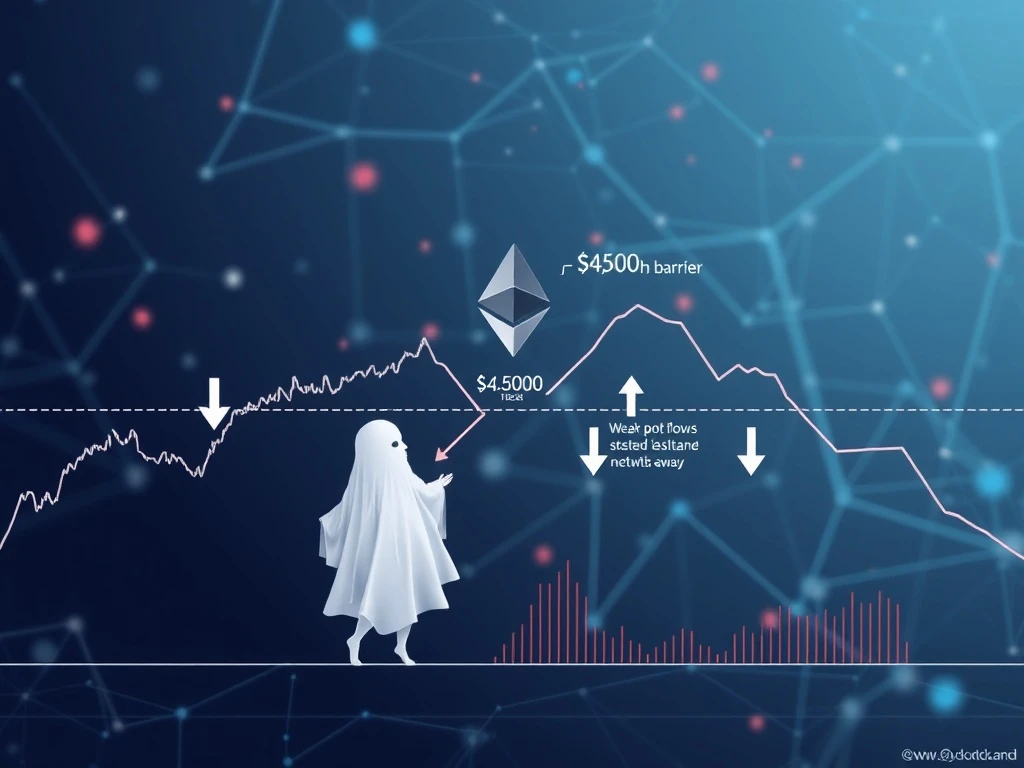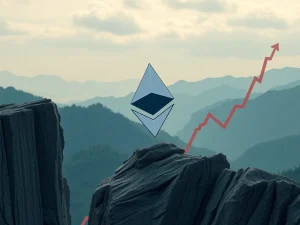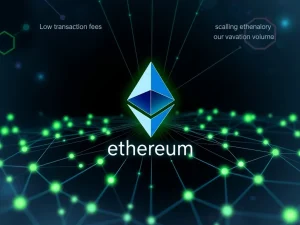Ethereum Price: Why the Crucial $4.5K Barrier Remains Unbroken

The cryptocurrency market watches closely as Ethereum price struggles to overcome a significant hurdle. Despite its strong position as the second-largest digital asset, ETH has consistently failed to break past the crucial $4.5K barrier. This persistent resistance raises questions among investors and analysts alike. What factors are holding back this crypto giant? This article explores the key elements contributing to Ethereum’s current stagnation and potential future movements, helping you understand the complex forces at play.
Understanding Ethereum Price Resistance at $4.5K
Recently, the Ethereum price has displayed a concerning pattern. Since reaching its recent highs near $4,950, ETH has formed a series of lower highs and lower lows on the daily chart. This price action indicates a weakening bullish momentum. Consequently, the $4,500 level, once a support, has now transformed into a formidable resistance. For more than ten days, this critical threshold has suppressed the altcoin’s upward movement. Overcoming this resistance is essential for any sustained recovery.
Several factors contribute to this persistent struggle. Traders are observing a shift in market dynamics. The previous enthusiasm appears to have waned. Moreover, technical indicators now signal potential downside risks. Investors therefore need to consider these signals carefully. The market often reflects a battle between buyers and sellers. Currently, sellers seem to hold the upper hand around the $4,500 mark, preventing the ETH price from advancing.
ETH/USD daily chart. Source: Crypto News Insights/TradingView
Why Fresh ETH Buyers Are Hesitating
Ethereum’s ability to push above the $4,500 resistance appears significantly limited. This is primarily due to a noticeable absence of new ETH buyers. The spot volume delta metric clearly illustrates this trend. This indicator measures the net difference between buying and selling trade volumes on exchanges. Currently, it shows negative net spot buying, even as the Ethereum price consolidates. This suggests that sellers are more active than buyers in the spot market.
This lack of buying pressure has critical implications. Price recovery efforts may lack the necessary momentum to sustain upward moves. Consequently, the market could experience continued consolidation or even a deeper pullback. Without genuine demand, any attempt to break out above key levels might quickly falter. Therefore, a renewed influx of ETH buyers is absolutely necessary to reignite the long-term uptrend. Their participation is vital for pushing the price higher.
Bitcoin’s post volume delta. Source: Glassnode
Declining Demand for Spot Ethereum ETFs
Demand for spot Ethereum ETF products has also seen a significant decrease. Data from SoSoValue reveals consistent outflows from these investment vehicles recently. Last week alone, Ether ETFs posted outflows every single day. On one particular Friday, Ether ETFs shed a substantial $446.8 million. This brought the total outflows for that week to a staggering -$787.6 million. These figures highlight a weakening institutional and retail interest in ETH through regulated products.
Such significant outflows can exert downward pressure on the Ethereum price. They signal that large investors are withdrawing capital rather than allocating more. For ETH to break out of its current range and target levels like $5,000, it must attract fresh capital. New ETH buyers are crucial, especially those coming through regulated investment products. Without this renewed interest, the path to recovery remains challenging. The performance of these ETFs often reflects broader market sentiment.
Spot Ethereum ETF flows table. Source: SoSoValue
Analyzing Ethereum’s Futures Open Interest and Leverage
The derivatives market also reflects this cautious sentiment. Decreased demand for leverage has led to a sharp drop in Ether futures open interest (OI). Open interest measures the total number of ETH futures contracts across all derivatives exchanges. These include major platforms like CME, Binance, Bybit, and OKX. Recently, OI fell by 18%, dropping from an all-time high of $70 billion to $58 billion.
While futures longs (buyers) and shorts (sellers) always remain matched, a declining OI is significant. It suggests reduced leverage and lower market participation overall. This typically signals weaker bullish sentiment among traders. For example, a similar 18% decrease in OI observed between late July and early August previously coincided with a 15% drop in ETH price. Therefore, this current reduction in open interest is a bearish indicator for the immediate future of the Ethereum price.
ETH futures aggregate open interest, USD. Source: CoinGlass
The Impact of Slumping Network Activity on ETH Price
Beyond market sentiment and investment products, Ethereum network activity itself has seen a slump. This directly impacts the fundamental value proposition of ETH. Ethereum revenue, which represents the share of network fees accruing to Ether holders through token burns, dropped significantly. It fell by about 44% recently, even as the price briefly hit higher levels. Revenue for the period totaled over $14.1 million, a decrease from the previous period’s $25.6 million, according to Token Terminal.
This drop occurred despite ETH rallying substantially over recent months. The decline also coincides with about a 10% drop in network fees over the last 30 days, totaling approximately $43.3 million, as per Nansen data. A large part of Ethereum’s fall in revenue stems from the Dencun upgrade in March 2024. This upgrade significantly lowered transaction fees for layer-2 scaling networks using Ethereum as their base layer. While beneficial for users, it cuts fee revenue and impacts ETH’s deflationary mechanism. This can potentially weaken the Ethereum price momentum over time.
30-day performance of top blockchains. Source: Nansen
Technical Outlook: Is $3,500 on the Horizon for ETH Price?
From a technical analysis perspective, the ETH price has formed a descending triangle pattern on its daily chart since mid-August. This pattern features a flat support level combined with a downward-sloping resistance line. A descending triangle appearing after a strong uptrend is generally considered a bearish reversal indicator. This setup typically resolves when the price breaks below the flat support level. The subsequent fall often equals the triangle’s maximum height.
A daily candlestick close below the triangle’s support line at $4,200 would confirm a continuation of the downtrend. This would put the measured target of the pattern at $3,550 in play. Such a move would represent an 18% drop from current price levels. However, some analysts suggest an earlier bounce is possible. Investor and trader Ted Pillows noted that ETH price is “looking strong” above $4,200. He added that a deeper drop to retest the $3,800-$3,900 zone was possible before a reversal. This highlights the uncertainty in the market. Another potential area to watch for a rebound is $3,745, especially if the $4,250 support is lost. Therefore, ETH buyers must monitor these critical levels closely.
ETH/USD daily chart. Source: Crypto News Insights/TradingView
This article does not contain investment advice or recommendations. Every investment and trading move involves risk, and readers should conduct their own research when making a decision.








